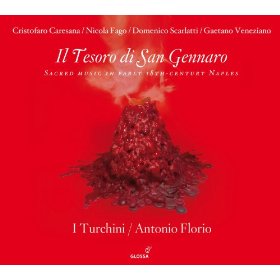Texte paru dans: / Appeared in:

Fanfare Magazine: 36:5 (05-06/2013)
Pour
s'abonner / Subscription information
Les abonnés à Fanfare Magazine ont accès aux archives du
magazine sur internet.
Subscribers to Fanfare Magazine have access to the archives of the magazine
on the net.
Glossa
GCD922605

Code-barres / Barcode : 8424562226050
The subtitle, “Sacred Music in Early 18th-Century Naples,” reminds us that San Gennaro (Januarius) is the patron saint of that city, or rather one of scores of patron saints whose intercession in calamity the citizens begged. The two largest works on this program are an impressive Stabat Mater by Nicola Fago (1677-1745), set exceptionally for four voices (not, for Naples, the usual two), and a motet Antra valles Divo plaudant in honor of St. John the Baptist by Domenico Scarlatti. The former, a contemporary of Scarlatti and several of the greatest composers of the late Baroque, is a new name in my collection. Fago succeeded Cristofaro Caresana (1640-1709) as maestro di cappella of the chapel connected with the cathedral and known as the Treasury of San Gennaro, where the relic of the martyr’s blood is venerated. Fago was a pupil of Caresana’s predecessor, Francesco Provenzale. The other two composers heard here, Domenico Scarlatti and Gaetano Veneziano (1665-1716), were members of the Real (royal) Cappella, the viceroy’s chapel, where Alessandro Scarlatti had been director and Provenzale and Caresana had also been members. Scarlatti is also noted here for three sinfonie, drawn from the 17 sinfonie uniquely preserved in Paris, the only secular pieces on the disc.
Hence this
program is a cross-section of Neapolitan sacred music around the beginning
of the 18th century. Caresana is represented by a canzona in honor of San
Gennaro to be sung on one of his feast days (there were three). A second
work by Fago is the Vespers psalm Confitebor tibi, one of five that he
wrote. Veneziano is represented by three Office hymns for one or two voices
with instruments. This continues a series of Neapolitan programs that this
ensemble has given us. The six mixed voices and eight players toss off the
rapid figures with an appreciation of the style that prevailed at the time.
Devotees of this period will appreciate
this
disc.
Fermer la fenêtre/Close window
Cliquez l'un ou l'autre
bouton pour découvrir bien d'autres critiques de CD
Click either button for many other reviews


